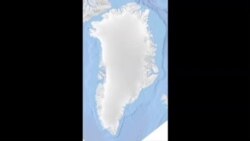A new study finds dramatic new thinning in the Greenland ice sheet in a region that was considered stable until now.
Last July, Kurt Kjaer was collecting sample sediment cores from a lake bed in southeastern Greenland when his science team witnessed a dramatic event.
“We landed and suddenly you could feel that the ground was starting to shake," he remembers.
The research director of the Natural History Museum of Denmark at the University of Copenhagen is co-author of the new study about the Greenland ice sheet.
“We turned around and we could see, ‘Oh, there’s a calving event.' Two huge icebergs that are 700 meters deep that are coming out of there, that has been released from the glacier and that is turning around," Kjaer said. "And you can actually pick up the signal from seismic space due to the shaking of the earth all the way down to Japan.”
Ice sheets - like those in Greenland and Antarctica - are constantly in motion. Calving at the ocean’s edge is part that natural cycle as the ice mass flows downhill under its own weight, moving through ice streams, glaciers and ice shelves. The sheet remains stable as long as it accumulates the same mass of snow that it loses at sea.
For their study in Nature Climate Change, the scientists collected surface elevation from the entire ice sheet using satellite data. While they knew that the southeast and northwest were already losing mass at accelerated rates, Kjaer says they hadn’t expected to see sustained loss in northeastern Greenland, which was considered stable.
Kurt Kjaer of the University of Copenhagen describes the ice mass loss in northeastern Greenland. (Credit: Kristian Kjellerup Kjeldsen, Natural History Museum of Denmark)
“It’s a new area that started to react to a warmer climate," he said. "And it’s warming in the sense that it’s a warmer summer temperatures and warmer ocean temperatures.”
Reduced sea ice where the glacier meets the warmer ocean allows icebergs to break off from the edge of the shelf. That causes the ice stream to accelerate toward the sea. The northeastern ice stream drains almost 16 percent of Greenland.
Kjaer's findings will likely affect the models of future sea level rise.
“Of course it’s a concern," he said. "If you have an area in Greenland like the northeastern section that has been considered stable and not contributing to any significant sea level rise, it somewhat a bigger surprise you can say.”
He adds that scientists will look back at the history of the ice sheet, to put the more recent observations in perspective.
“But my feeling is that we will see that mass lost that we are seeing over the last ten years is something out of the ordinary.”
Kjaer says the new data will improve predictions of changes in a warmer world.
Last July, Kurt Kjaer was collecting sample sediment cores from a lake bed in southeastern Greenland when his science team witnessed a dramatic event.
“We landed and suddenly you could feel that the ground was starting to shake," he remembers.
The research director of the Natural History Museum of Denmark at the University of Copenhagen is co-author of the new study about the Greenland ice sheet.
“We turned around and we could see, ‘Oh, there’s a calving event.' Two huge icebergs that are 700 meters deep that are coming out of there, that has been released from the glacier and that is turning around," Kjaer said. "And you can actually pick up the signal from seismic space due to the shaking of the earth all the way down to Japan.”
Ice sheets - like those in Greenland and Antarctica - are constantly in motion. Calving at the ocean’s edge is part that natural cycle as the ice mass flows downhill under its own weight, moving through ice streams, glaciers and ice shelves. The sheet remains stable as long as it accumulates the same mass of snow that it loses at sea.
For their study in Nature Climate Change, the scientists collected surface elevation from the entire ice sheet using satellite data. While they knew that the southeast and northwest were already losing mass at accelerated rates, Kjaer says they hadn’t expected to see sustained loss in northeastern Greenland, which was considered stable.
Kurt Kjaer of the University of Copenhagen describes the ice mass loss in northeastern Greenland. (Credit: Kristian Kjellerup Kjeldsen, Natural History Museum of Denmark)
“It’s a new area that started to react to a warmer climate," he said. "And it’s warming in the sense that it’s a warmer summer temperatures and warmer ocean temperatures.”
Reduced sea ice where the glacier meets the warmer ocean allows icebergs to break off from the edge of the shelf. That causes the ice stream to accelerate toward the sea. The northeastern ice stream drains almost 16 percent of Greenland.
Kjaer's findings will likely affect the models of future sea level rise.
“Of course it’s a concern," he said. "If you have an area in Greenland like the northeastern section that has been considered stable and not contributing to any significant sea level rise, it somewhat a bigger surprise you can say.”
He adds that scientists will look back at the history of the ice sheet, to put the more recent observations in perspective.
“But my feeling is that we will see that mass lost that we are seeing over the last ten years is something out of the ordinary.”
Kjaer says the new data will improve predictions of changes in a warmer world.









